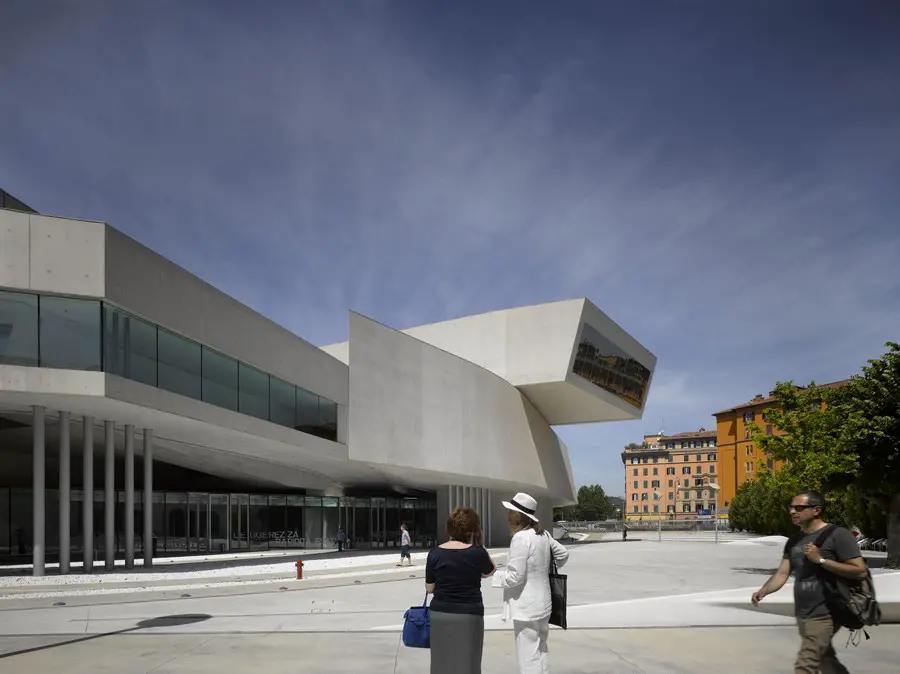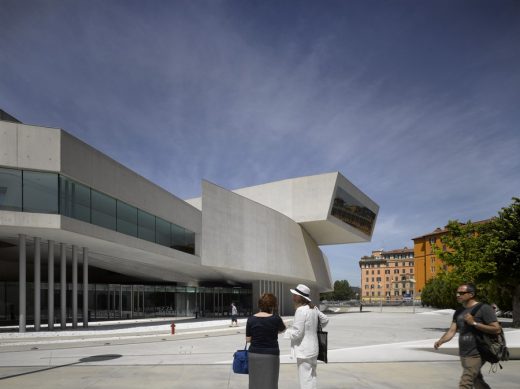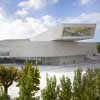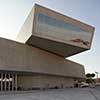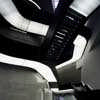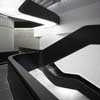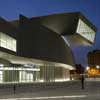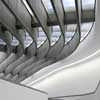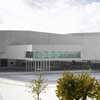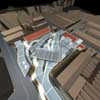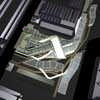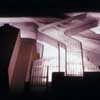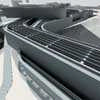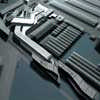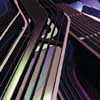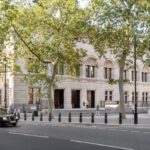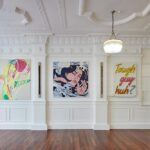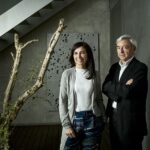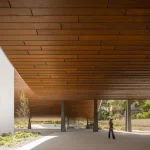Maxxi Rome building photos, Zaha Hadid architect Italian art museum design images
MAXXI – National Centre of Contemporary Arts Rome
Contemporary Roman Building design by Zaha Hadid Architects in Italy.
post updated 16 June 2025
Architect Zaha Hadid described this building at the time of its opening thus:
“I see the MAXXI as an immersive urban environment for the exchange of ideas, feeding the cultural vitality of the city. It’s no longer just a museum, but an urban cultural centre where a dense texture of interior and exterior spaces have been intertwined and superimposed over one another. It’s an intriguing mixture of galleries, irrigating a large urban field with linear display surfaces”.
MAXXI Museum of XXI Century Art, Rome, in the city from above:
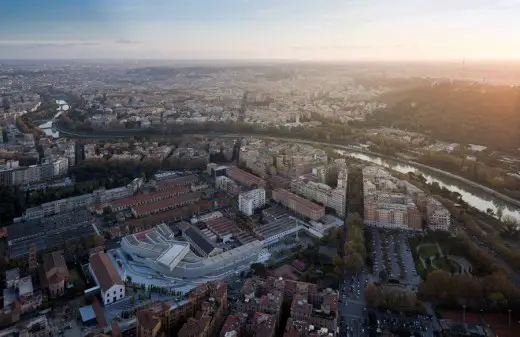
photo : Iwan Baan
24 Apr 2012
MAXXI Roma – Administration News
Artforum report that the Italian government is moving to replace the current board of directors of the Maxxi – Italy’s museum for contemporary art – with a special government-appointed administrator. The steps are being taken, according to the government, after the board failed to approve the museum’s 2012 budget, which is anticipated to put forth a significant deficit.
The deficit is caused in part by state cuts that will reduce the museum’s subsidies by nearly $2.4 million, which the board was expected to make up by raising funds from the private sector.
According to Povoledo in The New York Times, “Pio Baldi, the president of the Maxxi Foundation, said he had been ‘very surprised’ by the ministry’s decision, because the Maxxi ‘is a museum that’s doing very well,’ with some 450,000 visitors in 2011 alone.”
5 Nov 2010
MAXXI wins WAF Awards
For the second time in just three years Italy hosts the WAF World Building of the Year 2010
WAF Overall winner
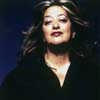
Zaha Hadid photo : Steve Double
MAXXI – National Museum of the XXI Century Arts, Rome, designed by Zaha Hadid Architects, wins World Building of the Year 2010
2 Oct 2010
MAXXI – Stirling Prize
Zaha Hadid Architects – Stirling Prize winner. Having been shortlisted many times, and with few buildings in the UK, Zaha Hadid at last wins the UK’s premier architecture award, the Stirling Prize.
22 Jul / 24 Sep 2010
MAXXI Award
Stirling Prize shortlist : six buildings – favourite to win according to betting odds. It would be the first time Zaha Hadid has won the Stirling Prize.
MAXXI Roma, Italia
2007-09
Zaha Hadid Architects
MAXXI Rome Opening
MAXXI – Grand opening 29 May 2010
MAXXI – National Museum of the XXI Century Arts – via Guido Reni 4a, Rome
THE MINISTER FOR CULTURAL HERITAGE SANDRO BONDI
THE MINISTER FOR INFRASTRUCTURE ALTERO MATTEOLI
THE ARCHITECT ZAHA HADID PRESENT THE MAXXI PREVIEW TODAY
18 Nov 2009
MAXXI Photography by Roland Halbe
MAXXI Rome Building Opening
EXTRAORDINARY OPENING OF THE NEW MUSEUM
WITH A CHOREOGRAPHIC INSTALLATION BY SASHA WALTZ
Rome, November 12, 2009 – MAXXI, the National Museum of the XXI Century Arts – designed by Zaha Hadid Architects – sees the light.
Today, 12 November, with completion of the MAXXI building, the presentation to the Italian and international press and the architectural preview of the new museum took place in Rome. The following participated: the Minister for Cultural Heritage and Activities, Sandro Bondi, the Minister for Infrastructure, Altero Matteoli, the President of the MAXXI Foundation, Pio Baldi and the architect Zaha Hadid – the first woman to be awarded the Pritzker Prize in 2004 and recently the Praemium Imperiale Prize of the Japan Art Association – who illustrated “her” revolutionary and futuristic museum.
The Councillor for culture and communication policies of the Municipality of Rome Umberto Croppi, the Directors of MAXXI Arts and MAXXI Architecture, Anna Mattirolo and Margherita Guccione, were also present, as well as technicians, designers and the companies Italiana Costruzioni SpA and SAC SpA, which completed the works in the high-tech building yard.
The Minister for Cultural Heritage and Activities, Sandro Bondi, stated: “Today MAXXI has reached its completion. In few months’ time these extraordinary architectural premises in Rome will host a permanent collection of visual arts, exhibitions and events, which will turn this first national museum devoted to contemporary arts into a cultural centre of excellence, entrusted to a Foundation to which the best energies of the country will certainly take part and provide their contribution”.
Pio Baldi stated: “MAXXI will not be a museum as the others. It will not only be a place where to exhibit works of art. MAXXI will be a research workshop for comparing different contemporary languages: design, fashion, cinema and advertising will establish a dialogue with art and architecture. The museum will be a real factory of creativity. Its cultural mission will be inspired by three key words: innovation, multiculturalism and interdisciplinarity”.
MAXXI Rome – Photography by Roland Halbe
SASHA WALTZ / DIALOGE 09 – MAXXI
On 14 & 15 November – in line with the interdisciplinary approach and confluence of languages inherent in its DNA – the MAXXI will host a choreographic installation specifically created by Sasha Waltz. It is a tribute to Zaha Hadid’s fluid and dynamic lines and forms, which will come to life in the bodies and movements of a group of dancers and musicians (co-production by the MAXXI Foundation and Sasha Waltz & Guest; project and organization by the Romaeuropa Foundation).
MAXXI Rome Building Background
MAXXI TOWARDS THE INAUGURATION OF 2010
Since last July MAXXI has been definiteively established in Rome as a Foundation, so far fully owned by the Ministry for Cultural Heritage and Activities, but open to cooperation and integration with other public and private entities.
The definiteive opening of the MAXXI museum is envisaged in spring 2010 and is strongly supported by Minister Sandro Bondi, as the crowning achievement of a multiannual commitment by the Ministry for Cultural Heritage and Activities.
MAXXI Rome – campus for culture
The MAXXI_Museum is the first national museum dedicated to contemporary creativity, designed as a multidisciplinary space for experimentation and innovation in arts and architecture.
Designed by architect Zaha Hadid (winner of the international competition in 1999), the MAXXI is located in the Flaminio quarter of Rome, in the area of the former Montello military barracks.
The complex houses two institutions: MAXXI Arte (Director Anna Mattirolo) and MAXXI Architecture (Director Margherita Guccione), aiming to promote art and architecture through collection, conservation, study and exhibition of contemporary works. As of today, over 300 works are part of the MAXXI Art collection in Rome, including those of Boetti, Clemente, Kapoor, Kentridge, Merz, Penone, Pintaldi, Richter, Warhol and many others.
MAXXI Architecture includes the files of the designs of Carlo Scarpa, Aldo Rossi, Pierluigi Nervi and others, as well as the projects of contemporary authors such as Toyo Ito, Italo Rota and Giancarlo De Carlo, and photography collections of the projects Italian Atlas and Author’s Site.
Designed as a true multi-disciplinary and multi-purpose campus of the arts and culture, the MAXXI creates an urban complex for the city that can be enjoyed by all. The MAXXI includes – in addition to the two museums – an auditorium, library and media library, bookshop and cafeteria, spaces for temporary exhibitions, outdoor spaces, live events and commercial activities, laboratories, and places for study and leisure.
The architecture of MAXXI
The design by Zaha Hadid is woven into the city’s fabric with an architectural arrangement based on the idea of an urban campus. In the MAXXI, the idea of a “closed” building gives way to a broader dimension, creating both indoor and outdoor spaces that become part of the surrounding city.
The two museums – MAXXI Art and MAXXI Architecture – are located around a large full height space which gives access to the galleries dedicated to permanent collections and temporary exhibitions, the auditorium, reception services, cafeteria and bookshop. Outside, a pedestrian walkway follows the outline of the building, restoring an urban link that has been blocked for almost a century by the former military barracks in Rome.
Materials such as glass (roof), steel (stairs) and cement (walls) give the exhibition spaces a neutral appearance, whilst mobile panels enable curatorial flexibility and variety.
The fluid and sinuous shapes, the variety and interweaving of spaces and the modulated use of natural light lead to a spatial and functional framework of great complexity, offering constantly changing and unexpected views from within the building and outdoor spaces.
Two principle architectural elements characterize the project: the concrete walls that define the exhibition galleries and determine the interweaving of volumes; and the transparent roof that modulates natural light. The roofing system complies with the highest standards required for museums and is composed of integrated frames and louvers with devices for filtering sunlight, artificial light and environmental control.
MAXXI numbers
Total site area: 29,000 m2 / Exterior spaces: 19,640 m2 / Interior spaces: 21,200 m2 / Display space: 10.000 m2 / Services (auditorium, library-video library, cafeteria, restaurant, etc.): 6,000 m2 / MAXXI Arts: 4.077 m2 / MAXXI Architecture: 1,935 m2 / Total volume: 113,000 m3 / Maximum height: 22.90 m / Demolitions of existing structures: 100,000 m3 / Structural steel: 6,000,000 kg / Steel roof trusses: 700,000 kg / Site poured structural concrete: 50,000 m3 / Formwork area: 40,000 m2 of which 20,000 m2 exposed / Area of glass skylights: 2,600 m2 / Number of people employed by the MAXXI: an average of 100 people per day (technicians and labourers) for 1,500 days / Hours of construction time: 1,250,000 / Project cost: 150 million Euro / Visitor forecast: between 200 and 400 thousand per year.
MAXXI – Inaugural Exhibitions
Five exhibitions have been envisaged for the opening of this new Rome Museum in spring 2010.
Spazio! by an interdisciplinary group composed of Pippo Ciorra, Alessandro D’Onofrio, Bartolomeo Pietromarchi, Gabi Scardi and the MAXXI curators. Catalogue by Stefano Chiodi and Domitilla Dardi. It is a unique pathway through the MAXXI Arts and MAXXI Architecture collections.
Gino De Dominicis. 1947 – 1998, by Achille Bonito Oliva, is the first anthological exhibition devoted to the artist, accompanied by a catalogue which outlines not only the exhibition, but also his entire work.
Kutlug Ataman, Mesopotamian Dramaturgies, by Cristiana Perrella.
Luigi Moretti, by Bruno Reiclin and Maristella Casciato.
Geografie italiane, multimedia installation by Studio Azzurro.
MAXXI Rome images / information from Zaha Hadid Architects 181109
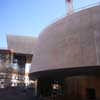
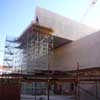
Maxxi Photographs © Adrian Welch Feb 2008
The Contemporary Art and Architecture Centre for Rome is the first national museum for contemporary art in Italy.
Maxxi Images from Zaha Hadid Architects:
The new Institution has been established by act of parliament and the design of the building is the first concrete step in the creation of the institution. A large urban site in the Flaminia district on the northern edge of the historic centre of Rome has been allocated for the building.
The centre comprises spaces for permanent, temporary and commercial galleries, an architecture centre, a conference centre as well as a library.
The concept for the project is based on the idea of ‘irrigating’ the large urban field with linear display surfaces, weaving a dense texture of interior and exterior spaces. The institution is thus rendered porous for the casual visitor, either providing en passe delight or enticing entry.
Our design for the Contemporary Art Centre in Rome was awarded the 1st Prize in an International Design Competition in February 1999. We have been awarded the full contract for all architectural and engineering services. Construction of MAXXI Rome begins in 2003, and the project is scheduled for completion in 2007.
MAXXI Rome images / information from Zaha Hadid Architects 110408
Maxxi Rome architect : Zaha Hadid Architects
Location: north Rome, Italy
National Centre of Contemporary Arts Rome – Building Information
MAXXI: NATIONAL CENTRE OF CONTEMPORARY ARTS [ROME, ITALY]
1997-2007 [under construction]
PROGRAM: Contemporary art and architecture centre, temporary exhibition spaces
CLIENT: Italian Ministry of Culture, Rome, Italy
ARCHITECT: Design Zaha Hadid with Patrik Schumacher
Project Architect: Gianluca Racana [Zaha Hadid]
Local Architect: ABT srl [Rome, Italy]
CONSULTANTS: Structure Anthony Hunt Associates [London, UK]
OK Design Group [Rome, Italy]
M&E: Max Fordham and Partners [London, UK] – Max Fordham
OK Design Group [Rome, Italy]
Lighting: Equation Lighting [London, UK]
Acoustic: Paul Gilleron Acoustic [London, UK]
SIZE/AREA : 30,000 m2
MAXXI Roma Event, Italy
2011
‘Y1/CITYVISION independent architecture stuff’
Location: MAXXI, Rome, Italy
Architecture in Rome
Rome Architecture Designs – chronological list
City of Sun, near Via della Lega Lombarda & Tiburtina Station, East Rome
Architects: Labics
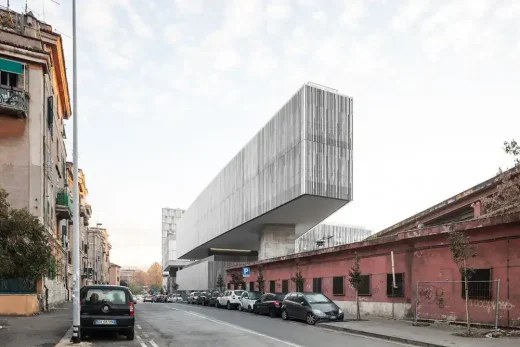
photograph : Marco Cappelletti
City of Sun in Rome
Rome Architecture : New buildings
Italian Buildings by Zaha Hadid Architects
Cagliari museum, Italy
Comments / photos for the MAXXI Building Rome – Italian architecture by ZHA page welcome
Website: www.fondazionemaxxi.it

